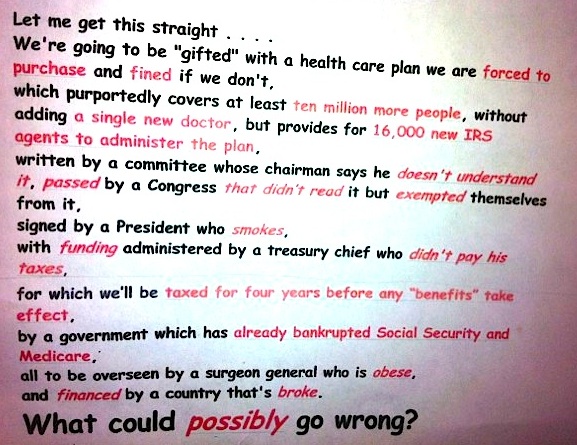More On Medicare Part B’s Hidden Tax Increases
Stanley Feld M.D.,FACP MACE
In addition to the increase in premiums for Medicare Part B, there are additional hidden costs. These hidden costs for care could be viewed as a hidden tax. These costs have been increasing yearly.
The government’s cost to fulfill its obligations to the Medicare entitlement program has increased yearly. The Medicare premium increases have not covered the government’s increased costs. The government has increased seniors’ Medicare deductible in order to cover some of its expense.
At the same time, the government has blamed the increased costs on increasing physicians’ fees. Physicians have not been able to increase their fees for several years.
Physicians are the most disorganized and least represented of all the healthcare stakeholders. They are the easiest to attack. Physicians’ reimbursements have, in fact, consistently been decreased.
An increasing number of physicians are opting out of accepting Medicare. Patients pay physicians directly. The patient then submits the bill to Medicare. Medicare reimburses patients directly.
Physicians are under no obligation to accept Medicare’s allowable fee schedule when they do not accept Medicare. Physicians’ fees are generally higher than Medicare’s allowable fee. The full fee represents a further increase in the cost of Medicare coverage.
If physicians accept Medicare, they are required by law to accept Medicare’s allowable fee.
Many physicians have stopped accepting new Medicare patients. This has intensified the physician shortage for seniors. It has also resulted in decreasing access to care.
I received a note from a reader asking me why he had to pay $182 dollars to his internist for an office visit and an x-ray. He has Medicare Part B and Medicare Part F (Medigap) insurance. He thought this coverage would pay the entire fee. He paid cash and eventually received $2.24 from Medicare.
He stated he did not have to pay anything for a previous visit.
I asked him to send me the Medicare explanation of benefits(EOB). It made no sense.
In studying the explanation of benefits several things became clear.
1. His internist stopped participating in Medicare.
2.He did not tell this to the patient.
3. The internist told the patient that the $182 covered his annual Medicare deductible.
The description of Part B coverage in the Medicare manual is as follows;
“Part B: (covers Medicare eligible physician services, outpatient hospital services, certain home health services, durable medical equipment)
- $162.00 per year. (Note: You pay 20% of the Medicare-approved amount for services after you meet the $162.00 deductible.)
Additional information about the Medicare premiums, deductibles, and coinsurance rates for 2011 is available in the November 4, 2010 Fact Sheet titled, "Medicare Premiums, Deductibles for 2011" on the www.cms.gov website.”
The patient also had Medigap (Medicare Part F). Part F covers Medicare Part B deductibles and the 20% co-pay of Medicare allowable charges. It also covers Skilled Nursing facilities allowable charges and Medicare Part A deductible plus 20% of the co-pay for Part A. Part A covers hospitalization.
“Medicare Supplement Plan F covers:
- Basic benefits including
- Hospitalization: pays Part A coinsurance plus coverage for 365 additional days after Medicare benefits end
- Medical Expenses: pays Part B coinsurance – generally 20 percent of Medicare-approved expenses – or copayments for hospital outpatient services
- Blood: pays for the first three pints of blood each year
- Hospice care: pays Part A coinsurance
In addition to the basic benefits, Plan F also provides coverage for:
- Skilled nursing facility care
- Medicare Part A deductible for hospitalization
- Medicare Part B deductible for medical and hospital outpatient expenses
- Medicare Part B excess charges (This is the difference between what a doctor or provider charges and the amount Medicare will pay up to Medicare's limiting amount)
- Travel-abroad medical emergency help
If this patient went to a physician that accepted Medicare, he would have been fully insured. In this case the physician did not accept Medicare. The physician omitted attaching the patients Medicare Part F coverage information in submitting Medicare Part B form for the patient.
By not accepting Medicare, physicians are allowed to collect their entire fee from patients. The physician billed the patient $182.86. Medicare allowed $164.78.
The patient’s Medicare deductible for 2011 is $162. Therefore Medicare paid the patient $2.78 for a total of 164.78. Physicians are permitted to “balance bill” when not accepting Medicare.
His physician can collect and keep the additional $28.08. If he accepted Medicare, it would be against the law to collect and keep the extra $28.08.
As Medicare continues to reduce physicians’ reimbursement, physicians, who in the past accepted Medicare, are dropping out and directly billing patients.
If this patient’s Medicare Part F information were attached to the Medicare Part B bill, Medicare would have sent the allowable fee explanation of benefits to the Medicare Part F carrier. The Medicare Part F carrier would have sent the allowable fee for his deductible of $162 to the patient.
Additionally, Medicare Part F premiums have increased each year. It is not sensible to be without Medicare Part F coverage.
Patients must be aware of the coverage details. They must learn how to read the explanation of benefits (EOBs). They must make sure they are not overcharged or mischarged.
Part A, hospital coverage, is even more complex and confusing. Many overcharges can be found when studying the EOBs.
Medicare coverage is not cheap.
The opinions expressed in the blog “Repairing The Healthcare System” are, mine and mine alone.



The blog is substantial. This could enlighten the minds of many American citizens.